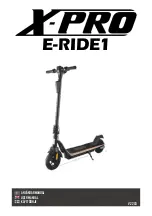
14
SEAT
Appropriate adjustments can be made to seat (or saddle) & handlebar height according to personal preference.
QUICK-RELEASE CLAMP
The clamps that hold handlebar or seat posts in place are called quick-release clamps. If you need to tighten or loosen the
clamp, use an adjustment knob located on the opposite side from the quick-release lever. Open the lever and turn the
adjustment knob clockwise. As you tighten the adjustment knob, you'll be able to close the lever more securely. In case you
tighten the knob too much, you won't be able to close the lever at all. Repeat this process until you find a "happy medium"
point where the lever is tight enough to hold the post, but not so tight that you cannot close the lever all the way.
MAX MARK LINE
When adjusting the height of the seat or handlebar posts, it is forbidden to expose
the MAX mark line (also called, the safety line or infix notation). If used
inappropriately, it may cause serious injury to the rider.
SEAT HEIGHT ADJUSTMENT
Stand over the frame and sit on the saddle. Step on the pedal with your heel. Rotate
the pedal to its lowest position while straightening the leg. The height is best suited
when the leg is straightened out with a slightly bent knee. If the leg is excessively
bent, raise the seat. If your knee is fully extended, lower the seat.
To do so, unlatch the quick-release lever on the seat tube and move the vertical stem to the appropriate height, making sure
not to exceed the safety MAX mark. Point the front tip of the seat towards the handlebar along the frame. Close the quick-
release lever while making sure it’s tight enough to keep the seat post in place.
SEAT POSITION ADJUSTMENT
The seat should be at a neutral position allowing the rider to sit on the middle portion of it without sliding forward onto the
nose or backward off the rear of the saddle. The seat position can be adjusted by loosening the seat clamp under the seat
and sliding the seat forward or backward. Be sure to loosen the clamp only enough to move the seat. You may need to test-
ride the bike with the new adjustment several times until you make sure this seat position is the most comfortable.
GENERAL OPERATION & MAINTENANCE
Like any other means of transportation, electric bicycle and its components are subject to wear and tear. When comparing
to regular bicycles, the rate of wear for electric bikes is higher due to its weight and speed; it does not mean the
components are defective or of low quality. The rate of wear depends on the way of use (mileage, terrain, weather
conditions, etc.), as well as the level of care and maintenance.
The use of a bicycle in competitive events, aggressive riding, riding on severe terrain/climates, riding with heavy loads,
commercial activities, and other types of non-standard use can dramatically shorten the life of the bicycle and its
components. Be sure to use your bicycle for its intended purpose only.
MAX LINE
Summary of Contents for ONYX
Page 4: ...4 STRUCTURE OF YOUR E BIKE...
Page 5: ...5 SIZING...





































